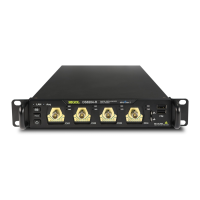Chapter 6 Operations and Measurements RIGOL
DS8000-R User Guide 6-29
3. Delay A →B : indicates the time difference between the threshold middle
values of the rising edge of Source A and the falling edge of Source B. Negative
delay indicates that the rising edge of Source A occurred after the falling edge of
Source B.
4. Delay A →B : indicates the time difference between the threshold middle
values of the falling edge of Source A and the rising edge of Source B. Negative
delay indicates that the falling edge of Source A occurred after the rising edge of
Source B.
5. Phase A →B : indicates the phase deviation between the threshold middle
values of the rising edge of Source A and that of Source B. It is expressed in
degree. The formula is as follows:
°360×=
sourceA
RR
RR
Period
BDelayA
BPhaseA
represents
Delay A →B , and
represents period of Source A.
6. Phase A →B : indicates the phase deviation between the threshold middle
values of the falling edge of Source A and that of Source B. It is expressed in
degree. The formula is as follows:
°360×=
sourceA
FF
FF
Period
BDelayA
BPhaseA
represents
Delay A →B , and
represents period of Source A.
7. Phase A →B : indicates the phase deviation between the threshold middle
values of the rising edge of Source A and falling edge of Source B. It is
expressed in degree. The formula is as follows:
°360×=
sourceA
FR
FR
Period
BDelayA
BPhaseA
represents
Delay A →B , and
represents period of Source A.
8. Phase A →B : indicates the phase deviation between the threshold middle
values of the falling edge of Source A and the rising edge of Source B. It is
expressed in degree. The formula is as follows:
°360×=
sourceA
RF
RF
Period
BDelayA
BPhaseA
represents
Delay A →B , and
represents period of Source A.

